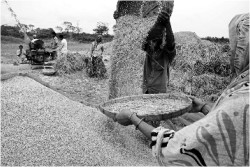Rainwater harvesting
Dr. Manoranjan Mondal
 |
Anisur Rahman |
Rainwater harvesting refers to the collection and storage of rainwater in-situ or within the vicinity of rainfall. Traditionally, rainwater harvesting has been practiced in arid and semi-arid areas for drinking water, domestic water, water for livestock, water for small irrigation and a way to replenish groundwater. Currently in China and Brazil, rooftop rainwater harvesting is being practiced to meet up various requirements. In Bermuda, the law requires all new construction to include rainwater harvesting adequate for the residents. In the Ayerwaddy Delta of Myanmar, groundwater is saline and the communities rely on mud lined rainwater ponds to meet their drinking water needs throughout the dry season. Some of these ponds are centuries old and are treated with great reverence and respect.
Why we harvest
rainwater?
Rainwater harvesting in urban areas can have manifold reasons. The main reason is to provide supplemental water for the city's requirements. In New Zealand, many houses away from the larger towns routinely rely on rainwater as the source of water for all household activities. In the rural areas, it is mainly harvested for domestic and agricultural purposes. The farmers of Barind tract and the people of the saline affected coastal regions of Bangladesh harvest rainwater for crop production, drinking and domestic use.
History of rainwater harvest in Indian sub-continent
In ancient days the Indians knew the methods of rainwater conservation. There are evidences that, even during Harappan period, there was very good system of rainwater harvest and its management. In Tamil Nadu, the ancient people stored rainwater separately for drinking and for bathing and other domestic purposes. This procedure is also found in the coastal regions of Bangladesh. The people harvest rainwater in separate ponds and use this water for drinking after filtering using pond-sand filter.
Method of rainwater
harvest
Rainwater is either harvested from the ground or from a roof. Ground catchment systems are generally considered in areas where rainwater is very scarce and other sources of water are not available. Roof catchment systems channel rainwater that falls onto a roof into storage via a system of gutters and pipes. The first flush of rainwater after a dry season should be allowed to run to waste as it will be contaminated with dust, bird droppings etc. Traditional rainwater harvesting, which is still prevalent in rural areas, was done in surface storage bodies like lakes, ponds and irrigation tanks. The volume of rainwater that could be harvested can be calculated by multiplying the catchment area by the amount of rainfall over that area taking into consideration of losses. Rainwater that flows along the ground during rains, called runoff, can be collected to a tank below the surface. It is a very 'easy to adopt' technology proven with many communities.
Rainwater harvest for agriculture
Even though agriculture is an integral part of rural livelihoods of communities all over the world, there are many instances when farmers in water scarce areas are unable to succeed in their agricultural ventures due to the unavailability of water at right time and in right amounts. Rainwater harvesting can be effectively used by resource poor farming households to overcome the hardships of nature. The use of rainwater harvesting for agriculture has become common as a result of the intermittent nature of rains in many Asian counties and is widely practiced in areas where there is a failure of the seasonal rains, or drier climatic conditions persist for most part of the year. Rainwater harvesting technology helps to store water in rainy seasons, for usage, during the drought period.
Conservation for aman rice cultivation
In Bangladesh, about 2000 mm rainfall occurred in the monsoon, which is more than the optimum water requirement for successful cultivation of Aman rice. But in most cases, rainfall is not uniformly distributed and for that only a portion of total rainfall is effectively utilized in crop production, and the remaining portion goes out as surface runoff form the rice field due to lack of proper management practices. Rainfall could be utilized more beneficially if it is stored and managed properly. Bangladesh Rice Research Institute (BRRI) reported that 90% of the total rainfall can be conserved in the paddy fields by constructing and maintaining 15 cm levees around the fields. This technique of rainwater harvest is sufficient to stabilize aman rice yield in moderate drought scenarios. BRRI also reported that in drought-prone areas, construction of farm pond in 5% of the land areas with 2 m deep is sufficient for supplemental irrigation to stabilize rice yield. This is economically viable even if there is a drought once in five years.
Conservation for boro rice cultivation
Rainfall dominates the cropping in the coastal regions of Bangladesh. Intensification of agriculture in this region largely depends on the extent of irrigation facility during post monsoon period. Groundwater is not suitable for irrigation and river water remains saline during dry season. The alternative source is rainwater that can be harvested for crop cultivation. Many farmers of the coastal districts constructed farm reservoir for fish and rice cultivation. A study conducted by Khulna University showed that about 20% reservoir area is sufficient to conserve rainwater for cultivation of short duration high yielding rice (like BRRI dhan28) in the dry season.
Concluding remarks
Fresh water is a scarce resource; scarcity of which is increasing day by day. Although we are experiencing flood every year, water scarcity is pronounced in the dry season. The International Water Management Institute (IWMI) estimated that Bangladesh will face economic scarcity of water by 2025. Besides, sea level rise due to climate change phenomenon will further degrade our fresh water resources. We may not have sufficient fresh water for drinking and food production. Under these circumstances, rainwater harvest and its judicious utilisation for agriculture and municipal use would be essential in our future life.
The writer is a Consultant (Agriculture), BRAC, Dhaka. |

